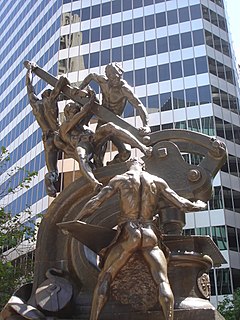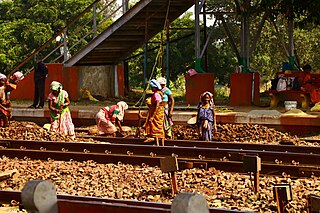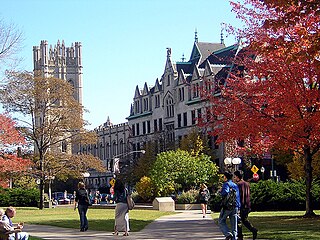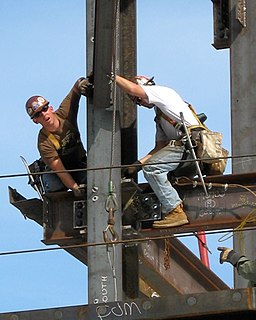
A social class is a set of concepts in the social sciences and political theory centered on models of social stratification which occurs in class society, in which people are grouped into a set of hierarchical social categories, the most common being the upper, middle and lower classes. While there is not one agreed-upon way to categorize social classes, most sociologists believe that a person's membership in one can be dependent on many factors including, but not limited to: education, wealth, occupation, income, and belonging to a particular subculture or social network.

Nickel and Dimed: On (Not) Getting By in America is a book written by Barbara Ehrenreich. Written from her perspective as an undercover journalist, it sets out to investigate the impact of the 1996 welfare reform act on the working poor in the United States.

Social class in the United States refers to the idea of grouping Americans by some measure of social status, typically economic. However, it could also refer to social status or location. The idea that American society can be divided into social classes is disputed, and there are many competing class systems.
The middle class is a class of people in the middle of a social hierarchy. Its usage has often been vague whether defined in terms of occupation, income, education or social status. The definition by any author is often chosen for political connotations. Modern social theorists—and especially economists—have defined and re-defined the term "middle class" in order to serve their particular social or political ends.
Seniority is the state of being older or placed in a higher position of status relative to another individual, group, or organization. For example, one employee may be senior to another either by role or rank, or by having more years served within the organization. The term "seniority" can apply to either concept or both concurrently.

The working poor are working people whose incomes fall below a given poverty line due to low-income jobs and low familial household income. These are people who spend at least 27 weeks in a year working or looking for employment, but remain under the poverty threshold.

In sociology, the upper middle class is the social group constituted by higher status members of the middle class. This is in contrast to the term lower middle class, which is used for the group at the opposite end of the middle-class stratum, and to the broader term middle class. There is considerable debate as to how the upper middle class might be defined. According to sociologist Max Weber, the upper middle class consists of well-educated professionals with postgraduate degrees and comfortable incomes.

Social stratification refers to a society's categorization of its people into groups based on socioeconomic factors like wealth, income, race, education, ethnicity, gender, occupation, social status, or derived power. As such, stratification is the relative social position of persons within a social group, category, geographic region, or social unit.
The American middle class is a social class in the United States. While the concept is typically ambiguous in popular opinion and common language use, contemporary social scientists have put forward several ostensibly congruent theories on the American middle class. Depending on the class model used, the middle class constitutes anywhere from 25% to 66% of households.

The educational attainment of the U.S. population refers to the highest level of education completed. The educational attainment of the U.S. population is similar to that of many other industrialized countries with the vast majority of the population having completed secondary education and a rising number of college graduates that outnumber high school dropouts. As a whole, the population of the United States is spending more years in formal educational programs. As with income, levels differ by race, age, household configuration, and geography.
Affluence refers to an individual's or household's economical and financial advantage in comparison to others. It may be assessed through either income or wealth.
The terms average Joe, ordinary Joe, Joe Sixpack, Joe Lunchbucket, Joe Snuffy, Joe Schmo and ordinary Jane, average Jane, and plain Jane, are used primarily in North America to refer to a completely average person, typically an average American. It can be used both to give the image of a hypothetical "completely average person" or to describe an existing person. Parallel terms in other languages for local equivalents exist worldwide.
The Gilbert model was developed by Dennis Gilbert as a means of a more effective way of classifying people in a given society into social classes.
In sociology, the upper middle class of the United States is the social group constituted by higher-status members of the middle class. This is in contrast to the term lower middle class, which refers to the group at the opposite end of the middle class scale. There is considerable debate as to how the upper middle class might be defined. According to Max Weber, the upper middle class consists of well-educated professionals with graduate degrees and comfortable incomes.
Collar color is a set of terms denoting groups of working individuals based on the colors of their collars worn at work. These can commonly reflect one's occupation within a broad class, or sometimes gender.; at least in the late 20th and 21st Century these are generally metaphorical and not a description of typical present apparel. For the two terms of longest use, white-collar workers are named for the white-collared shirts that were fashionable among office workers in the early and mid-20th century. Blue-collar workers are referred to as such because in the early 20th century, they usually wore sturdy, inexpensive clothing that did not show dirt easily, such as blue denim or cambric shirts.

The society of the United States is based on Western culture, and has been developing since long before the United States became a country with its own unique social and cultural characteristics such as dialect, music, arts, social habits, cuisine, and folklore. Today, the United States of America is an ethnically and racially diverse country as a result of large-scale immigration from many different countries throughout its history.
In the United States, the concept of a working class remains vaguely defined, and classifying people or jobs into this class can be contentious. Economists and pollsters in the United States generally define "working class" adults as those lacking a college degree, rather than by occupation or income. Many members of the working class, as defined by academic models, are often identified in the vernacular as being middle-class, there is considerable ambiguity over the term's meaning. According to Frank Newport, "for some, working class is a more literal label; namely, an indication that one is working." Sociologists such as Dennis Gilbert and Joseph Kahl see the working class as the most populous in the United States, while other sociologists such as William Thompson, Joseph Hickey and James Henslin deem the lower middle class slightly more populous. In the class models devised by these sociologists, the working class comprises between 30% and 35% of the population, roughly the same percentages as the lower middle class. According to the class model by Dennis Gilbert, the working class comprises those between the 25th and 55th percentile of society. In 2018, 31% of Americans self described themselves as working class. Retired American adults are less likely to describe themselves as "working class", regardless of the actual income or education level of the adult. Those in the working class are commonly employed in clerical, retail sales, and low-skill manual labor occupations. Low-level white-collar workers are included in this class.
Social privilege is a theory of special advantage or entitlement, used to one's own benefit or to the detriment of others. These groups can be advantaged based on social class, age, height, nationality, disability, ethnic or racial category, gender, gender identity, neurology, sexual orientation, and religion. It is generally considered to be a theoretical concept used in a variety of subjects and often linked to social inequality. Privilege is also linked to social and cultural forms of power. It began as an academic concept, but has since been invoked more widely, outside of academia.
The professional–managerial class (PMC) is an influential new class hypothesis in social science in the United States in the 1970s by John and Barbara Ehrenreich. The Ehrenreichs hypothesized a social class within capitalism that, by controlling production processes through superior management skills, was neither proletarian nor bourgeois. This hypothesis contributed to the Marxist debates on class in Fordism and was used as an analytical category in the examination of non-proletarian employees.

The working class comprises those engaged in waged or salaried labour, especially in manual-labour occupations and industrial work. Working-class occupations include blue-collar jobs, some white-collar jobs, and most pink-collar jobs. Members of the working class rely exclusively upon earnings from wage labour; thus, according to more inclusive definitions, the category can include almost all of the working population of industrialized economies, as well as those employed in the urban areas of non-industrialized economies or in the rural workforce.









